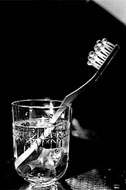|

Comment
on this story
What:
Michiko Kon: Still Lifes
Where:
Knoxville Museum of Art, 1050 World's Fair Park Drive (call 525-6101 for information)
When:
Through Aug. 10
|
|

Artist Michiko Kon's fantastic obsessions
by Heather Joyner
Although more than 70 photographic prints by Michiko Kon are currently on display at the KMA, Kon is not really a photographer. Instead, she is an artist who captures the objects she makes on film. The perishable nature of the materials she uses—fruit, flowers, chicken parts, various types of fish, etc.—is one factor possibly dictating her chosen medium. Another might be the unnerving effects that can be achieved when things "unreal" are presented within the "truthful" context of photography. Nevertheless, Kon's work is about her constructions themselves rather than the composition of her photographs—an important distinction.
Viewing Kon's images in the museum's large upstairs gallery feels like trespassing upon the artist's subconscious mind. Beyond the initial impact of their darkness, her prints reveal a highly individualistic perception. But what sets Kon's brand of Surrealism apart from that of her many predecessors is a complex mingling of aspects both symbolic and personal. Whereas the ordinary transformed into something altogether different is typically surreal (think Méret Oppenheim's fur teacup or Man Ray's useless iron), Kon takes the act of transmogrification a step farther.
A bustier made from pond herrings safety-pinned together...a cuttlefish-encrusted chair with doll's legs...a high-heeled pump with salmon scales and flatfish trim...herein, the notion of utilizing raw materials is given entirely new meaning. And all of Kon's objects address issues of life and death, as well as present the unexpected. Universal symbols meet private fetishes in constructions that are simultaneously clever, disorienting, and disgusting. Seeing some pieces is like rubbernecking a car wreck—we can't not look, no matter how horrifying the spectacle.
Despite the intensity of Kon's metaphors, her objects seem primarily activated by how things look. After all, it is visual precision that makes her allusions possible. Art historian and critic Toshiharu Ito suggests that even more than texture, contrast, or form comes into play, saying, "Not only sight, but touch, smell, taste, and hearing are engaged with the object as if it were a live performance.... [Kon] reconstructs and reconfirms the senses. Her works stimulate the unconscious associations of an image's sensory elements beyond those of sight. When we look at her photographs, we feel as if all the senses are thrown into commotion." However that commotion is arrived at, it can be overwhelming.
What, then, is Kon's objective? She may want to throw viewers off balance, but disorientation alone is pointless. It seems she strives to create assemblages that force us to see everyday objects in combinations that challenge their significance. And like Doctor Frankenstein, Kon plays God by resurrecting once living things—assigning animals and insects new roles. For example, in "Cicada Exoskeletons And Dress" (1990), numerous locust shells both adorn a garment and comment on its function in relation to human beings. Like a carapace, clothing shields us and aids in our identification. As such, clothing is a persistent theme in Kon's work, seen in pieces like "Gizzard Shad And Brassiere" (1986), "Shrimp And Boot" (1992), and "Sardines And Apron" (1994).
Kon's gift is her ability to not only transform, but to layer meaning upon meaning—much as one layers sweaters. Says Ito, "...inorganic substances become living organisms, dissolution becomes integration, and death manages to make its way into life. And the deeper the extent of this infinity, the more thrilling the object becomes, and the more multidimensional the image becomes."
At times parading as playful, the artist's objects actually serve a serious purpose: to translate her interior world into palpable, exterior form. "Kon is shaken but resolutely unwilling to abandon the direction of her own emotions, experimenting with visualizing the secret desires and passions clinging to the underside of her emotion's fabric," Ito says. As for the passions inhabiting Kon's work, they are numerous and often unappealing. A psychologist would have a field day with pieces like "Cabbages And Bed #2" and "Human Body, Apples, and Cow Bone." The earlier image shows a bed with a suggestive slit down its middle, seemingly birthing five heads of cabbage. The latter title labels an assemblage in which a decapitated doll body wrapped in apple peelings stands upright, its stump arms crafted from fish parts and its "neck and head" in the form of a cow bone. It's a truly nasty little number...one that makes us wonder what demons Kon wishes to exorcise.
Constructions emphasizing deformity, mutilation, and decay dominate Kon's most recent work (including four-color images in which red takes over), and they appear heavy-handed when compared to other efforts. Aside from being disturbing, they seem less imaginative than pieces reflecting a larger context. For Kon, when that larger context employs a plenitude of similar elements like fish eyes, she effectively refers to repetition found within the cycle of life and to surrealist exploration in general, albeit in her own distinctive way. As an icon of Surrealism, the eye represents vision; in Kon's work—as the eye of a fish—it also represents her native Japan. That multiplicity of meaning is Kon's greatest achievement, and it's what will sustain our interest no matter what she does next.

May 29, 2003 * Vol. 13, No. 22
© 2003 Metro Pulse
|